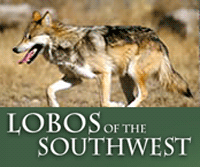For immediate release: March 31, 2025
Media contacts:
Greta Anderson, Western Watersheds Project (520) 623-1878; This email address is being protected from spambots. You need JavaScript enabled to view it.
Chris Smith, WildEarth Guardians (505) 395-6177, This email address is being protected from spambots. You need JavaScript enabled to view it.
Sally Paez, New Mexico Wild (505) 350-0664, This email address is being protected from spambots. You need JavaScript enabled to view it.
Nico Lorenzen, Wild Arizona (520) 289-0147, This email address is being protected from spambots. You need JavaScript enabled to view it.
Claire Musser, Grand Canyon Wolf Recovery Project (928) 202-1325 This email address is being protected from spambots. You need JavaScript enabled to view it.
Regan Downey, Wolf Conservation Center (914) 763-2373, This email address is being protected from spambots. You need JavaScript enabled to view it.
Jacqueline Covey, Defenders of Wildlife (630) 427-7164, This email address is being protected from spambots. You need JavaScript enabled to view it.
Taylor McKinnon, Center for Biological Diversity (801) 300-2414, This email address is being protected from spambots. You need JavaScript enabled to view it.
Wandering Wolf “Ella” Found Deceased in New Mexico
ALBUQUERQUE, N.M. – The Mexican gray wolf who just last week was located north of Interstate 40 near Mount Taylor in New Mexico was found dead on Sunday, March 30, 2025. The U.S. Fish and Wildlife Service has indicated that the cause of Ella’s death is under investigation. She was named “Ella” by schoolchildren and her intrepid spirit was the subject of news coverage over the weekend.
“We’re deeply saddened that her journey has come to an end, because her roaming was teaching us about where Mexican gray wolves choose to be,” said Greta Anderson, deputy director of Western Watersheds Project. “The agencies insist on keeping wolves south of Interstate 40 in Arizona and New Mexico based on the ‘historic range’ of the species, but wolves like Ella live in the present and they are showing us their species’ future is in an expanded northern range.”
“It’s always devastating when we lose a member of this still small and imperiled population," said Chris Smith, wildlife program director for WildEarth Guardians. "But when we find that a young, intrepid wolf like Ella is taken, it's especially painful. Eventually, lobos will re-colonize their historic range. Until then, we will fight for their survival."
“The rugged slopes of Mount Taylor and surrounding areas host healthy herds of elk and would provide exceptional wolf habitat if humans were not intent on excluding them,” said Sally Paez, staff attorney for New Mexico Wild. In 2022, the State of New Mexico added 54,000 acres to the Marquez Wildlife Management Area, which created the largest wildlife management area in the state and vastly expanded the network of unfragmented public lands and wildlife corridors near Mount Taylor. “It is no surprise that a young wolf like Ella was drawn toward this wild landscape,” said Paez, “and we are deeply saddened by her loss.”
Mount Taylor is not only excellent lobo habitat; the area is also sacred land to Navajo, Acoma, Laguna, Hopi, Zuni, and other Indigenous peoples. The area holds about 1,000 cultural sites and has a rich cultural heritage and ceremonial importance to many people.
“Ella’s death is a profound loss—not just for her species, but for all of us who saw in her journey a glimpse of what recovery could look like,” said Claire Musser, executive director of the Grand Canyon Wolf Recovery Project. “She was young, instinct-driven, and full of possibility. By venturing north, she was reclaiming space that wolves once called home. Her story deserves more than mourning—it demands action to ensure other wolves have the freedom to thrive where she could not.”
"Ella's life was tragically short but deeply impactful, and we should strive to be like her as we work to create a better world for Mexican gray wolves," said Regan Downey, director of education at the Wolf Conservation Center. "Let's be bold and unapologetic in our quest to let lobos roam beyond the arbitrary boundary of I-40. Let's be like Ella."
“Mexican wolves like Ella have shown time and again that the wildlands north of Interstate 40 are desirable wolf habitat,” said Taylor McKinnon, Southwest director at the Center for Biological Diversity. “Her death is a tragedy and its cause and circumstances need to be investigated and shared with the public.”
“This female wolf’s motivation to disperse north is a key instinct that we celebrated just last week as it is indication that this species is poised to recover its historic range. We are, sadly, now learning of her death and investigating the cause,” said Craig Miller, Defenders of Wildlife senior Arizona representative. “Mexican gray wolves must be allowed to roam freely to new territories and find mates to strengthen their genetics for future healthy populations.”
“With Mexican grey wolves facing a panorama of threats including habitat degradation, genetic diversity loss, and threats to legislation that protects these imperiled wolves it is more important than ever to investigate these incidents and curb illegal mortality.” said Nico Lorenzen, conservation and wildlife associate with Wild Arizona.
There are 162 Mexican gray wolves known to be living in the wild in New Mexico, according to the latest annual census of the lobo population released by the agencies responsible for managing the species.
Illegal mortality is the leading cause of death for Mexican gray wolves. Conservationists and agencies have offered a combined reward of more than $105,000 for information leading to the conviction of anyone who violates the Endangered Species Act and unlawfully kills a Mexican wolf. Individuals with information they believe may be helpful are urged to call one of the following agencies: USFWS special agents in Pinetop, Arizona, at (346) 254-0515 or NMDGF Operation Game Thief at (800) 432-4263. Killing a Mexican wolf is a violation of state law and the Federal Endangered Species Act and can result in criminal penalties of up to $50,000, and/or not more than one year in jail, and/or a civil penalty of up to $25,000.
###






